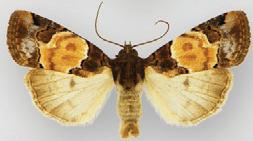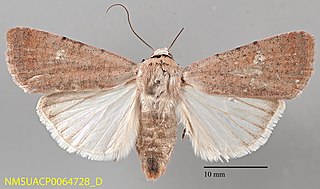
Drasteria is a genus of moths in the family Erebidae.

Drasteria adumbrata, the shadowy arches, is a moth of the family Erebidae. The species was first described by Hans Hermann Behr in 1870. It is found from coast to coast in southern Canada, south in the west to California and Colorado, south in the east to New England and Michigan. Subspecies D. a. alleni is found from eastern Alberta to New York and Nova Scotia. Subspecies D. a. saxea occurs from southern British Columbia and south-west Alberta south to California and Colorado.
Drasteria hudsonica, the northern arches, is a moth of the family Erebidae. The species was first described by Augustus Radcliffe Grote and Coleman Townsend Robinson in 1865. It is found from Alaska and Yukon to California, east to New Mexico and Manitoba.
Drasteria pallescens, the cowhead arches, is a moth of the family Erebidae. The species was first described by Augustus Radcliffe Grote and Coleman Townsend Robinson in 1866. It is found in North America from Alberta and Saskatchewan south to Texas and Baja California.
Drasteria perplexa, the perplexing or perplexed arches, is a moth of the family Erebidae. The species was first described by Henry Edwards in 1884. It is found in North America from Alberta and Saskatchewan south to Colorado and Arizona.
Drasteria petricola, the little arches, is a moth of the family Erebidae. The species was first described by Francis Walker in 1858. It is found in western North America from Yukon and the Northwest Territories south to New Mexico in the Rocky Mountains, east to Manitoba.
Drasteria grandirena, the figure-seven moth or great kidney, is a moth of the family Erebidae first described by Adrian Hardy Haworth in 1809. It is found in North America from Ontario, Quebec and Nova Scotia, south to at least Georgia west to at least Arkansas

Drasteria sabulosa is a moth of the family Erebidae. It is found from British Columbia south into the United States where it found as far east as Wyoming, Utah, Colorado, New Mexico and as far south as Arizona.
Drasteria hastingsii is a moth of the family Erebidae. It is found from British Columbia south to Oregon and California.
Drasteria tejonica is a moth of the family Erebidae. It has been recorded from California, Arizona, Colorado, Utah and New Mexico.
Drasteria mirifica is a moth of the family Erebidae. It is found in North America, including Nevada, Oregon and California.
Drasteria inepta, the inept drasteria, is a moth of the family Erebidae. It is found from Arizona to Texas, north to Colorado and Utah.

Bryolymnia biformata is a moth of the family Noctuidae. It is known only from the Huachuca, Patagonia, and Santa Rita Mountains in south-eastern Arizona.
Drasteria eubapta is a moth of the family Erebidae. It is found in North America, where it has been recorded from Arizona and California.
Drasteria maculosa is a moth of the family Erebidae. It is found in North America, where it has been recorded from Nevada and California.
Drasteria nubicola is a moth of the family Erebidae. It is found in North America, where it has been recorded from Nevada, California, Oregon and southern Idaho. The habitat consists of dry, open areas with sand dunes and salt flats.
Drasteria occulta, the occult drasteria moth, is a moth of the family Erebidae. The species was first described by Henry Edwards in 1881. It is found in North America, where it has been recorded from coastal areas in Maine, New Jersey, Pennsylvania and Texas. It is listed as a species of special concern and believed extirpated in the US state of Connecticut.
Drasteria scrupulosa is a moth of the family Erebidae. It is found in North America, where it has been recorded from California, Idaho, Nevada, Oregon and Utah. The habitat consists of open sagebrush steppes.
Drasteria stretchii is a moth of the family Erebidae. It is found in North America, where it has been recorded from northern Nevada., California, Oregon, Wyoming and Washington. The habitat consists of dry, rocky canyons at low to middle elevations.

Anicla biformata is a species of cutworm or dart moth in the family Noctuidae. It is found in North America.



